A Survey of Deep Learning Based NOMA: State of the Art, Key Aspects, Open Challenges and Future Trends
Abstract
1. Introduction
1.1. Background
1.2. Scope and Contributions
1.3. Organization of the Paper
2. Related Work
| Reference | Focus Area | Research Contribution |
|---|---|---|
| [11] | A comprehensive review of DL-based NOMA | This study surveys DL-based NOMA techniques, benefits, and challenges of DL integration with emerging technologies. It briefly discusses future directions for DL-based NOMA systems. |
| [19] | DL-based NOMA for 5G networks | It discusses DL-based NOMA models exploited for user detection, signal detection, channel allotment, power allocation and resource allocation. It also highlights the shortcomings and benefits of DL approaches to solve NOMA challenges. |
| [38] | Performance analysis of DL-based NOMA | It outlines DL-based NOMA, its challenges, and potential benefits. |
| [37] | Overview of NOMA | It focuses on NOMA’s impact on multi-cell networks. |
| [36] | Advantages of NOMA | It comprehensively discusses the benefits of NOMA and the integration of cognitive networks, MEC and MIMO. |
| [40] | DL’s impact on wireless communication | It discusses DL-based sum rate maximization for NOMA |
| [41] | NOMA in next-generation multiple access | It discusses NOMA as a promising candidate for 6G networks. It also discusses associated research opportunities and future visions. |
| [42] | DL for downlinking MIMO-NOMA systems | This article surveys DL in SP blocks of downlink MIMO-NOMA systems. It briefly outlines possible future research directions. |
| [43] | DL-enhanced NOMA transceiver designs for massive MTC | It comprehensively discusses state-of-the-art challenges and future directions for DL-enhanced NOMA systems from the perspectives of online adaptability and reconfigurability toward the ever-changing environment in future mMTC. |
| [44] | DL-based power allocation in NOMA | It provides a review of the power allocation optimization problem through DL methods. It also outlines various future research directions. |
| Our Work | DL-based NOMA | In this study, we comprehensively discuss state-of-the-art, key performance indicators, challenges, and future directions for DL-enhanced NOMA systems. We also discuss the integration of emerging technologies such as MEC, MIMO, OFDM, SWIPT and IRS with DL-based NOMA systems. |
3. Key Aspects for Practical Implementation of DL-Based NOMA
3.1. Resource Allocation
3.2. Power Allocation
| Reference | Technique | Model | System Description | Model Limitations | Research Contribution |
|---|---|---|---|---|---|
| [35] | Reinforcement | Deep neural networks | Physical layer framework, BS with multiple antennas and multiple single-antenna users | Complicated DNN, the data set acquisition and model selection problems | Introduces an efficient, cutting DL-assisted 5G and beyond communication. |
| [48] | Reinforcement | Artificial Neural Networks | Attention-based neural network exploiting an encoder-decoder structure, | The key problem is how to allocate limited resources to multiple users | Introduces a method to optimally allocate transmission resources through an attention-assisted neural network for channel assignment. |
| [50] | Unsupervised | K-mean | K-means-based online user clustering algorithm | It does not consider more complicated clustering algorithms that are robust to noises and outliers | Satisfy the total transmission power sum-rate maximization issue until the QoS demands of the users. |
| [52] | Reinforcement | Q-learning | A single base station in a NOMA system equipped with multiple antennas contending with a smart jammer | It considers a simplified jamming scenario. Theoretical analysis of more practical scenarios is still needed. | In the occupancy of a jamming device, the BS carries out our execution of power distribution. The process is developed as a game with a zero-sum outcome. |
| [53] | Reinforcement | Special Neural Network | Single BS using cooperative reinforcement learning algorithm for adaptive power allocation in D2D communication | It considers a single-cell setup, while a multi-cell setup is still required. | Considering the OFDM system without NOMA, maximize overall SU interference while keeping data rate and power. |
| [54] | Reinforcement | Q-learning | Dynamic multichannel access problem, where multiple correlated channels consider an unknown joint Markov model | Computationally expensive, DQN is not easy to tune, and more realistic and complicated scenarios such as multi-user systems are not considered. | Channel switching technique for realizing dynamic systems. |
| [55] | Supervised | CNN | The power control scheme in D2D communication in multi-channel based on CNN | Compared with DNN, it still lacks fitting ability. | Maximization of throughput by configuring the power. |
| [56] | Reinforcement | Two DNNs connected fully | DNN-based multi-channel cognitive radio networks, where the secondary user uses channels without interference from the primary user. | This system does not consider an optimal DNN structure. | Considering an underlay cognitive radio network, it focuses on maximizing spectral efficiency. Keeping the interference of primary users below the threshold, the secondary users provide high spectral efficiency. |
3.3. Channel State Information
3.4. Successive Interference Cancellation
| Context | [77] | [78] | [79] | [80] | [81] | [76] |
|---|---|---|---|---|---|---|
| CR-NOMA | Yes | Yes | Yes | Yes | Yes | Yes |
| Downlink | Yes | Yes | Yes | Yes | Yes | Yes |
| Uplink | - | - | - | - | - | - |
| Imperfect SIC | Yes | Yes | Yes | - | - | Yes |
| Imperfect CSI | - | - | - | - | Yes | Yes |
| OP analysis | Yes | - | Yes | Yes | Yes | Yes |
| Throughput | - | Yes | - | Yes | - | Yes |
3.5. User Fairness
3.6. Impulse Noise
3.6.1. Impact of IN in NOMA
3.6.2. IN Mitigation Techniques
3.7. Transceiver Design
Multiuser Detection Design [98,99,100,101,102,103,104,105,106]
3.8. DL for Channel Estimation
3.9. DL for Beamforming and Selection
3.10. DL for Modulation and Signal Processing
4. Integration of DL-Based NOMA with Emerging Technologies
4.1. Mobile Edge Computing (MEC)
| Reference | NOMA Incorporation | Number of Users | Offloading Mode | DL-Based Algorithm | Key Potential |
|---|---|---|---|---|---|
| [134] | Yes | Single user | Partial | Yes | It gives better performance as compared to FDMA-based MA-MEC |
| [137] | Yes | Multi-user | Partial | Yes | It speeds up convergence for better solutions than conventional optimization approaches |
| [138] | Yes | Single user | Partial | Yes | The DRL-based algorithm can achieve the near-optimal offloading solution fastly after enough learning |
| [139] | Yes | Multi-user | Binary | No | It increases the number of users to offload tasks and reduces the users’ average offloading delay |
| [140] | Yes | Multi-user | Binary-Partial | No | It outperforms the binary computation offloading mode, and NOMA outperforms TDMA in the context of computation efficiency |
| [141] | No | Multi-user | Binary | Yes | It can achieve near-optimal performance while substantially reducing the computation time by more than an order of magnitude than existing optimization techniques |
4.2. OFDM-Based NOMA
4.3. IRS-Assisted NOMA
| Context | [158] | [159] | [160] | [161] | [162] | [163] | [164] | [165] |
|---|---|---|---|---|---|---|---|---|
| NOMA system | Yes | Yes | Yes | Yes | Yes | Yes | Yes | Yes |
| OMA comparison | Yes | Yes | Yes | Yes | Yes | - | - | - |
| Achievable rate optimization | Yes | - | Yes | - | - | - | Yes | Yes |
| Op analysis | - | Yes | - | Yes | Yes | Yes | Yes | - |
| Hardware impairment | - | - | - | - | Yes | Yes | - | |
| NLoS consideration | - | - | - | - | Yes | Yes | Yes | - |
| LoS consideration | Yes | Yes | Yes | Yes | - | - | - | Yes |
4.4. MIMO-Assisted NOMA
4.5. NOMA-Assisted SWIPT
5. Potential Challenges
5.1. Challenges in Resource Allocation
5.2. Challenges in Automatic Signal Detection
5.3. Development of End-to-End Framework
5.4. Implementation of More Than Three-User Pairing in Real-Time
5.5. Uplink NOMA
5.6. Hybrid NOMA
5.7. Mobility
5.8. Multicell NOMA Networks
5.9. Model Selection
5.10. Performance Analysis and Learning Mechanism
5.11. Imperfect Successive Interference Cancellation
5.12. Security Issues
6. Future Research Directions
6.1. Stability and Power Efficiency
6.2. Channel Atatistics
6.3. Novel Algorithms
6.4. Security
6.5. Receiver Complexity in SIC Implementation
6.6. Multi-Cell NOMA System
6.7. Mobility in NOMA
6.8. CSI in NOMA
7. Conclusions
Author Contributions
Funding
Institutional Review Board Statement
Informed Consent Statement
Data Availability Statement
Acknowledgments
Conflicts of Interest
References
- 3GPP. Telecommunication Management; Self-Organizing Networks (SON): Concepts and Requirements; 3GPP TS 32.500 V8.0.0; December 2008. Available online: https://www.arib.or.jp/english/html/overview/doc/STD-T63v9_20/5_Appendix/Rel8/32/32500-800.pdf (accessed on 20 November 2022).
- Aliu, O.G.; Imran, A.; Imran, M.A.; Evans, B. A survey of self organisation in future cellular networks. IEEE Commun. Surv. Tutor. 2012, 15, 336–361. [Google Scholar] [CrossRef]
- 3GPP. Telecommunication Management; Self-Organizing Networks (SON); Self-Healing Concepts and Requirements; 3GPP TS 32.541 V10.0.0; March 2011. Available online: https://www.etsi.org/deliver/etsi_ts/132500_132599/132541/10.00.00_60/ts_132541v100000p.pdf (accessed on 5 December 2022).
- Islam, S.R.; Avazov, N.; Dobre, O.A.; Kwak, K.S. Power-domain non-orthogonal multiple access (NOMA) in 5G systems: Potentials and challenges. IEEE Commun. Surv. Tutor. 2016, 19, 721–742. [Google Scholar] [CrossRef]
- Vaezpour, E.; Majzoobi, L.; Akbari, M.; Parsaeefard, S.; Yanikomeroglu, H. A Deep Learning-Based Approach for Cell Outage Compensation in NOMA Networks. IEEE Open J. Veh. Technol. 2022, 3, 149–166. [Google Scholar] [CrossRef]
- Su, X.; Yu, H.; Kim, W.; Choi, C.; Choi, D. Interference cancellation for non-orthogonal multiple access used in future wireless mobile networks. EURASIP J. Wirel. Commun. Netw. 2016, 2016, 231. [Google Scholar] [CrossRef]
- Liu, Q.; Lv, T.; Lin, Z. Energy-efficient transmission design in cooperative relaying systems using NOMA. IEEE Commun. Lett. 2018, 22, 594–597. [Google Scholar] [CrossRef]
- Ding, Z.; Peng, M.; Poor, H.V. Cooperative non-orthogonal multiple access in 5G systems. IEEE Commun. Lett. 2015, 19, 1462–1465. [Google Scholar] [CrossRef]
- Hossain, E.; Kim, D.I.; Bhargava, V.K. (Eds.) Cooperative Cellular Wireless Networks; Cambridge University Press: Cambridge, UK, 2011. [Google Scholar]
- Pouyanfar, S.; Sadiq, S.; Yan, Y.; Tian, H.; Tao, Y.; Reyes, M.P.; Shyu, M.-L.; Chen, S.-C.; Iyengar, S.S. A survey on deep learning: Algorithms, techniques, and applications. ACM Comput. Surv. 2018, 51, 1–36. [Google Scholar] [CrossRef]
- Andiappan, V.; Ponnusamy, V. Deep Learning Enhanced NOMA System: A Survey on Future Scope and Challenges. Wirel. Pers. Commun. 2022, 123, 839–877. [Google Scholar] [CrossRef]
- Index, C.V.N. Global Mobile Data Traffic Forecast Update, 2014–2019; Cisco: San Jose, CA, USA, 2015; White Paper 1 February 2015. [Google Scholar]
- Chin, W.H.; Fan, Z.; Haines, R. Emerging technologies and research challenges for 5G wireless networks. IEEE Wirel. Commun. 2014, 21, 106–112. [Google Scholar] [CrossRef]
- Islam, S.M.; Zeng, M.; Dobre, O.A. NOMA in 5G systems: Exciting possibilities for enhancing spectral efficiency. arXiv 2017, arXiv:1706.08215. [Google Scholar]
- Li, A.; Lan, Y.; Chen, X.; Jiang, H. Non-orthogonal multiple access (NOMA) for future downlink radio access of 5G. China Commun. 2015, 12, 28–37. [Google Scholar] [CrossRef]
- Ding, Z.; Yang, Z.; Fan, P.; Poor, H.V. On the performance of non-orthogonal multiple access in 5G systems with randomly deployed users. IEEE Signal Process. Lett. 2014, 21, 1501–1505. [Google Scholar] [CrossRef]
- Aldababsa, M.; Toka, M.; Gökçeli, S.; Kurt, G.K.; Kucur, O. A tutorial on nonorthogonal multiple access for 5G and beyond. Wirel. Commun. Mob. Comput. 2018, 2018, 1–24. [Google Scholar] [CrossRef]
- Wang, Y.; Ren, B.; Sun, S.; Kang, S.; Yue, X. Analysis of non-orthogonal multiple access for 5G. China Commun. 2016, 13, 52–66. [Google Scholar] [CrossRef]
- Senapati, R.K.; Tanna, P.J. Deep Learning-Based NOMA System for Enhancement of 5G Networks: A Review. IEEE Trans. Neural Netw. Learn. Syst. 2022. [Google Scholar] [CrossRef]
- Ali, M.S.; Tabassum, H.; Hossain, E. Dynamic user clustering and power allocation for uplink and downlink non-orthogonal multiple access (NOMA) systems. IEEE Access 2016, 4, 6325–6343. [Google Scholar] [CrossRef]
- Celik, A.; Tsai, M.C.; Radaydeh, R.M.; Al-Qahtani, F.S.; Alouini, M.S. Distributed user clustering and resource allocation for imperfect NOMA in heterogeneous networks. IEEE Trans. Commun. 2019, 67, 7211–7227. [Google Scholar] [CrossRef]
- Khaleelahmed, S.; VenkateswaraRao, N. Energy efficient power allocation using Salp Particle Swarm Optimization model in MIMO–NOMA systems. Wirel. Pers. Commun. 2020, 111, 1235–1254. [Google Scholar] [CrossRef]
- You, H.; Pan, Z.; Liu, N.; You, X. User clustering scheme for downlink hybrid NOMA systems based on genetic algorithm. IEEE Access 2020, 8, 129461–129468. [Google Scholar] [CrossRef]
- Sutton, R.S.; Barto, A.G. Reinforcement Learning: An Introduction; MIT Press: Cambridge, MA, USA, 2018. [Google Scholar]
- Onireti, O.; Zoha, A.; Moysen, J.; Imran, A.; Giupponi, L.; Imran, M.A.; Abu-Dayya, A. A cell outage management framework for dense heterogeneous networks. IEEE Trans. Veh. Technol. 2015, 65, 2097–2113. [Google Scholar] [CrossRef]
- Lee, J.; So, J. Reinforcement learning-based joint user pairing and power allocation in MIMO-NOMA systems. Sensors 2020, 20, 7094. [Google Scholar] [CrossRef] [PubMed]
- Alkhateeb, A.; Alex, S.; Varkey, P.; Li, Y.; Qu, Q.; Tujkovic, D. Deep learning coordinated beamforming for highly-mobile millimeter wave systems. IEEE Access 2018, 6, 37328–37348. [Google Scholar] [CrossRef]
- Ahmed, K.I.; Tabassum, H.; Hossain, E. Deep learning for radio resource allocation in multi-cell networks. IEEE Netw. 2019, 33, 188–195. [Google Scholar] [CrossRef]
- Liang, F.; Shen, C.; Yu, W.; Wu, F. Towards optimal power control via ensembling deep neural networks. IEEE Trans. Commun. 2019, 68, 1760–1776. [Google Scholar] [CrossRef]
- Yang, N.; Zhang, H.; Long, K.; Hsieh, H.Y.; Liu, J. Deep neural network for resource management in NOMA networks. IEEE Trans. Veh. Technol. 2019, 69, 876–886. [Google Scholar] [CrossRef]
- Qin, Z.; Yue, X.; Liu, Y.; Ding, Z.; Nallanathan, A. User association and resource allocation in unified NOMA enabled heterogeneous ultra dense networks. IEEE Commun. Mag. 2018, 56, 86–92. [Google Scholar] [CrossRef]
- Zhang, H.; Zhang, H.; Long, K.; Karagiannidis, G.K. Deep learning based radio resource management in NOMA networks: User association, subchannel and power allocation. IEEE Trans. Netw. Sci. Eng. 2020, 7, 2406–2415. [Google Scholar] [CrossRef]
- Qin, Z.; Ye, H.; Li, G.Y.; Juang, B.H.F. Deep learning in physical layer communications. IEEE Wirel. Commun. 2019, 26, 93–99. [Google Scholar] [CrossRef]
- Zhang, S.; Liu, J.; Rodrigues, T.K.; Kato, N. Deep Learning Techniques for Advancing 6G Communications in the Physical Layer. IEEE Wirel. Commun. 2021, 28, 141–147. [Google Scholar] [CrossRef]
- Huang, H.; Guo, S.; Gui, G.; Yang, Z.; Zhang, J.; Sari, H.; Adachi, F. Deep learning for physical-layer 5G wireless techniques: Opportunities, challenges and solutions. IEEE Wirel. Commun. 2019, 27, 214–222. [Google Scholar] [CrossRef]
- Vaezi, M.; Baduge, G.A.A.; Liu, Y.; Arafa, A.; Fang, F.; Ding, Z. Interplay between NOMA and other emerging technologies: A survey. IEEE Trans. Cogn. Commun. Netw. 2019, 5, 900–919. [Google Scholar] [CrossRef]
- Vaezi, M.; Schober, R.; Ding, Z.; Poor, H.V. Non-orthogonal multiple access: Common myths and critical questions. IEEE Wirel. Commun. 2019, 26, 174–180. [Google Scholar] [CrossRef]
- Hasan, M.K.; Shahjalal, M.; Islam, M.M.; Alam, M.M.; Ahmed, M.F.; Jang, Y.M. The role of deep learning in NOMA for 5G and beyond communications. In Proceedings of the 2020 International Conference on Artificial Intelligence in Information and Communication (ICAIIC), Fukuoka, Japan, 19–21 February 2020; IEEE: Piscataway Township, NJ, USA; pp. 303–307. [Google Scholar]
- Hussain, F.; Hassan, S.A.; Hussain, R.; Hossain, E. Machine learning for resource management in cellular and IoT networks: Potentials, current solutions, and open challenges. IEEE Commun. Surv. Tutor. 2020, 22, 1251–1275. [Google Scholar] [CrossRef]
- Dai, L.; Jiao, R.; Adachi, F.; Poor, H.V.; Hanzo, L. Deep learning for wireless communications: An emerging interdisciplinary paradigm. IEEE Wirel. Commun. 2020, 27, 133–139. [Google Scholar] [CrossRef]
- Liu, Y.; Yi, W.; Ding, Z.; Liu, X.; Dobre, O.A.; Al-Dhahir, N. Developing NOMA to Next Generation Multiple Access: Future Vision and Research Opportunities. IEEE Wirel. Commun. 2022, 29, 120–127. [Google Scholar] [CrossRef]
- Sanjana, T.; Suma, M.N. Deep Learning Approaches used in Downlink MIMO-NOMA System: A Survey. In Soft Computing and Signal Processing; Springer: Singapore, 2021; pp. 687–704. [Google Scholar]
- Ye, N.; An, J.; Yu, J. Deep-learning-enhanced NOMA transceiver design for massive MTC: Challenges, state of the art, and future directions. IEEE Wirel. Commun. 2021, 28, 66–73. [Google Scholar] [CrossRef]
- Elsaraf, Z.; Khan, F.A.; Ahmed, Q.Z. Deep Learning Based Power Allocation Schemes in NOMA Systems: A Review. In Proceedings of the 2021 26th International Conference on Automation and Computing (ICAC), Portsmouth, UK, 2–4 September 2021; IEEE: Piscataway Township, NJ, USA; pp. 1–6. [Google Scholar]
- Ding, Z.; Fan, P.; Poor, H.V. Impact of user pairing on 5G nonorthogonal multiple-access downlink transmissions. IEEE Trans. Veh. Technol. 2015, 65, 6010–6023. [Google Scholar] [CrossRef]
- Wang, S.; Lv, T.; Zhang, X. Multi-agent reinforcement learning-based user pairing in multi-carrier NOMA systems. In Proceedings of the 2019 IEEE International Conference on Communications Workshops (ICC Workshops), Shanghai, China, 20–24 May 2019; IEEE: Piscataway Township, NJ, USA; pp. 1–6. [Google Scholar]
- Jiang, F.; Gu, Z.; Sun, C.; Ma, R. Dynamic user pairing and power allocation for NOMA with deep reinforcement learning. In Proceedings of the 2021 IEEE Wireless Communications and Networking Conference (WCNC), Nanjing, China, 29 March–1 April 2021; IEEE: Piscataway Township, NJ, USA; pp. 1–6. [Google Scholar]
- He, C.; Hu, Y.; Chen, Y.; Zeng, B. Joint power allocation and channel assignment for NOMA with deep reinforcement learning. IEEE J. Sel. Areas Commun. 2019, 37, 2200–2210. [Google Scholar] [CrossRef]
- Saetan, W.; Thipchaksurat, S. Power allocation for sum rate maximization in 5G NOMA system with imperfect SIC: A deep learning approach. In Proceedings of the 2019 4th International Conference on Information Technology (InCIT), Bangkok, Thailand, 24–25 October 2019; IEEE: Piscataway Township, NJ, USA; pp. 195–198. [Google Scholar]
- Cui, J.; Ding, Z.; Fan, P.; Al-Dhahir, N. Unsupervised machine learning-based user clustering in millimeter-wave-NOMA systems. IEEE Trans. Wirel. Commun. 2018, 17, 7425–7440. [Google Scholar] [CrossRef]
- Ma, X.; Sun, H.; Hu, R.Q. Scheduling policy and power allocation for federated learning in NOMA based MEC. In Proceedings of the GLOBECOM 2020–2020 IEEE Global Communications Conference, Taipei, Taiwan, 8–10 December 2020; IEEE: Piscataway Township, NJ, USA; pp. 1–7. [Google Scholar]
- Xiao, L.; Li, Y.; Dai, C.; Dai, H.; Poor, H.V. Reinforcement learning-based NOMA power allocation in the presence of smart jamming. IEEE Trans. Veh. Technol. 2017, 67, 3377–3389. [Google Scholar] [CrossRef]
- Khan, M.I.; Alam, M.M.; Le Moullec, Y.; Yaacoub, E. Cooperative reinforcement learning for adaptive power allocation in device-to-device communication. In Proceedings of the 2018 IEEE 4th World Forum on Internet of Things (WF-IoT), Singapore, 5–8 February 2018; IEEE: Piscataway Township, NJ, USA; pp. 476–481. [Google Scholar]
- Wang, S.; Liu, H.; Gomes, P.H.; Krishnamachari, B. Deep reinforcement learning for dynamic multichannel access in wireless networks. IEEE Trans. Cogn. Commun. Netw. 2018, 4, 257–265. [Google Scholar] [CrossRef]
- Zhang, R.; Cui, J. Application of Convolutional Neural Network in multi-channel Scenario D2D Communication Transmitting Power Control. In Proceedings of the 2020 International Conference on Computer Vision, Image and Deep Learning (CVIDL), Chongqing, China, 10–12 July 2020; IEEE: Piscataway Township, NJ, USA; pp. 668–672. [Google Scholar]
- Lee, W. Resource allocation for multi-channel underlay cognitive radio network based on deep neural network. IEEE Commun. Lett. 2018, 22, 1942–1945. [Google Scholar] [CrossRef]
- Gui, G.; Huang, H.; Song, Y.; Sari, H. Deep learning for an effective nonorthogonal multiple access scheme. IEEE Trans. Veh. Technol. 2018, 67, 8440–8450. [Google Scholar] [CrossRef]
- Tan, Y.; Zhou, J.; Qin, J. Novel channel estimation for non-orthogonal multiple access systems. IEEE Signal Process. Lett. 2016, 23, 1781–1785. [Google Scholar] [CrossRef]
- Senel, K.; Tekinay, S. Optimal power allocation in NOMA systems with imperfect channel estimation. In Proceedings of the GLOBECOM 2017–2017 IEEE Global Communications Conference, Singapore, 4–8 December 2017; IEEE: Piscataway Township, NJ, USA, 2017; pp. 1–7. [Google Scholar]
- Gao, Y.; Xia, B.; Liu, Y.; Yao, Y.; Xiao, K.; Lu, G. Analysis of the dynamic ordered decoding for uplink NOMA systems with imperfect CSI. IEEE Trans. Veh. Technol. 2018, 67, 6647–6651. [Google Scholar] [CrossRef]
- Fan, D.; Gao, F.; Wang, G.; Zhong, Z.; Nallanathan, A. Angle domain signal processing-aided channel estimation for indoor 60-GHz TDD/FDD massive MIMO systems. IEEE J. Sel. Areas Commun. 2017, 35, 1948–1961. [Google Scholar] [CrossRef]
- O’Shea, T.J.; Erpek, T.; Clancy, T.C. Deep learning based MIMO communications. arXiv 2017, arXiv:1707.07980. [Google Scholar]
- Hinton, G.E.; Osindero, S.; Teh, Y.W. A fast learning algorithm for deep belief nets. Neural Comput. 2006, 18, 1527–1554. [Google Scholar] [CrossRef]
- Wang, T.; Wen, C.; Wang, H.; Gao, F.; Jiang, T.; Jin, S. Deep learning for wireless physical layer: Opportunities and challenges. China Commun. 2017, 14, 92–111. [Google Scholar] [CrossRef]
- Wen, C.K.; Shih, W.T.; Jin, S. Deep learning for massive MIMO CSI feedback. IEEE Wirel. Commun. Lett. 2018, 7, 748–751. [Google Scholar] [CrossRef]
- Farsad, N.; Rao, M.; Goldsmith, A. Deep learning for joint source-channel coding of text. In Proceedings of the 2018 IEEE International Conference on Acoustics, Speech and Signal Processing (ICASSP), Calgary, AB, Canada, 15–20 April 2018; IEEE: Piscataway Township, NJ, USA; pp. 2326–2330. [Google Scholar]
- O’Shea, T.; Hoydis, J. An introduction to deep learning for the physical layer. IEEE Trans. Cogn. Commun. Netw. 2017, 3, 563–575. [Google Scholar] [CrossRef]
- Ye, H.; Li, G.Y.; Juang, B.H. Power of deep learning for channel estimation and signal detection in OFDM systems. IEEE Wirel. Commun. Lett. 2017, 7, 114–117. [Google Scholar] [CrossRef]
- Fadlullah, Z.M.; Tang, F.; Mao, B.; Kato, N.; Akashi, O.; Inoue, T.; Mizutani, K. State-of-the-art deep learning: Evolving machine intelligence toward tomorrow’s intelligent network traffic control systems. IEEE Commun. Surv. Tutor. 2017, 19, 2432–2455. [Google Scholar] [CrossRef]
- Tang, F.; Mao, B.; Fadlullah, Z.M.; Kato, N.; Akashi, O.; Inoue, T.; Mizutani, K. On removing routing protocol from future wireless networks: A real-time deep learning approach for intelligent traffic control. IEEE Wirel. Commun. 2017, 25, 154–160. [Google Scholar] [CrossRef]
- Abbasi, M.; Shahraki, A.; Taherkordi, A. Deep learning for network traffic monitoring and analysis (NTMA): A survey. Comput. Commun. 2021, 170, 19–41. [Google Scholar] [CrossRef]
- Chen, X.; Beiijebbour, A.; Li, A.; Jiang, H.; Kayama, H. Consideration on successive interference canceller (SIC) receiver at cell-edge users for non-orthogonal multiple access (NOMA) with SU-MIMO. In Proceedings of the 2015 IEEE 26th Annual International Symposium on Personal, Indoor, and Mobile Radio Communications (PIMRC), Hong Kong, China, 30 August–2 September 2015; IEEE: Piscataway Township, NJ, USA; pp. 522–526. [Google Scholar]
- Iraqi, Y.; Al-Dweik, A. Power allocation for reliable SIC detection of rectangular QAM-based NOMA systems. IEEE Trans. Veh. Technol. 2021, 70, 8355–8360. [Google Scholar] [CrossRef]
- Gao, W.; Han, C.; Chen, Z. DNN-powered SIC-free receiver artificial noise aided terahertz secure communications with randomly distributed eavesdroppers. IEEE Trans. Wirel. Commun. 2021, 21, 563–576. [Google Scholar] [CrossRef]
- Zhang, H.; Zhang, D.K.; Meng, W.X.; Li, C. User pairing algorithm with SIC in non-orthogonal multiple access system. In Proceedings of the 2016 IEEE International Conference on Communications (ICC), Kuala Lumpur, Malaysia, 23–27 May 2016; IEEE: Piscataway Township, NJ, USA; pp. 1–6. [Google Scholar]
- Vu, T.H.; Nguyen, T.V.; da Costa, D.B.; Kim, S. Performance analysis and deep learning design of underlay cognitive NOMA-based CDRT networks with imperfect SIC and co-channel interference. IEEE Trans. Commun. 2021, 69, 8159–8174. [Google Scholar] [CrossRef]
- Bariah, L.; Muhaidat, S.; Al-Dweik, A. Error performance of NOMA-based cognitive radio networks with partial relay selection and interference power constraints. IEEE Trans. Commun. 2019, 68, 765–777. [Google Scholar] [CrossRef]
- Luo, L.; Li, Q.; Cheng, J. Performance analysis of overlay cognitive NOMA systems with imperfect successive interference cancellation. IEEE Trans. Commun. 2020, 68, 4709–4722. [Google Scholar] [CrossRef]
- Chen, X.; Wen, M.; Mao, T.; Dang, S. Spectrum resource allocation based on cooperative NOMA with index modulation. IEEE Trans. Cogn. Commun. Netw. 2020, 6, 946–958. [Google Scholar] [CrossRef]
- Song, Y.; Yang, W.; Xiang, Z.; Wang, H.; Cao, F. Research on cognitive power allocation for secure millimeter-wave NOMA networks. IEEE Trans. Veh. Technol. 2020, 69, 13424–13436. [Google Scholar] [CrossRef]
- Zhou, F.; Chu, Z.; Sun, H.; Hu, R.Q.; Hanzo, L. Artificial noise aided secure cognitive beamforming for cooperative MISO-NOMA using SWIPT. IEEE J. Sel. Areas Commun. 2018, 36, 918–931. [Google Scholar] [CrossRef]
- Wu, J.; Sun, L.; Jia, Y. User Pairing and Power Allocation for NOMA-CoMP Based on Rate Prediction. Information 2022, 13, 200. [Google Scholar] [CrossRef]
- Wong, V.W.S.; Schober, R.; Ng, D.W.K.; Wang, C. Key Technologies for 5G Wireless System; Cambridge University Press: Cambridge, UK, 2017. [Google Scholar]
- Timotheou, S.; Krikidis, I. Fairness for non-orthogonal multiple access in 5G systems. IEEE Signal Process. Lett. 2015, 22, 1647–1651. [Google Scholar] [CrossRef]
- Bogale, T.E.; Le, L.B.; Haghighat, A.; Vandendorpe, L. On the number of RF chains and phase shifters, and scheduling design with hybrid analog–digital beamforming. IEEE Trans. Wirel. Commun. 2016, 15, 3311–3326. [Google Scholar] [CrossRef]
- Huang, H.; Yang, J.; Huang, H.; Song, Y.; Gui, G. Deep learning for super-resolution channel estimation and DOA estimation based massive MIMO system. IEEE Trans. Veh. Technol. 2018, 67, 8549–8560. [Google Scholar] [CrossRef]
- Do, T.; Le, A.T.; Vahid, A.; Sicker, D.; Jamalipour, A. A Deep Neural Network for Physical Layer Security Analysis in NOMA Reconfigurable Intelligent Surfaces-Aided IoT Systems. J. Latex Cl. Files 2022, 14. [Google Scholar]
- Emir, A.; Kara, F.; Kaya, H.; Li, X. Deep learning-based flexible joint channel estimation and signal detection of multi-user OFDM-NOMA. Phys. Commun. 2021, 48, 101443. [Google Scholar] [CrossRef]
- Hussain, M.; Shakir, H.; Rasheed, H. Deep Learning Approaches for Impulse Noise Mitigation and Classification in NOMA-Based Systems. IEEE Access 2021, 9, 143836–143846. [Google Scholar] [CrossRef]
- Hussain, M.; Rasheed, H. Performance of orthogonal beamforming with NOMA for smart grid communication in the presence of impulsive noise. Arab. J. Sci. Eng. 2020, 45, 6331–6345. [Google Scholar] [CrossRef]
- Selim, B.; Alam, M.S.; Kaddoum, G.; Agba, B.L. Effect of impulsive noise on uplink NOMA systems. IEEE Trans. Veh. Technol. 2020, 69, 3454–3458. [Google Scholar] [CrossRef]
- Selim, B.; Alam, M.S.; Evangelista, J.V.; Kaddoum, G.; Agba, B.L. NOMA-based IoT networks: Impulsive noise effects and mitigation. IEEE Commun. Mag. 2020, 58, 69–75. [Google Scholar] [CrossRef]
- Yih, C.H. Iterative interference cancellation for OFDM signals with blanking nonlinearity in impulsive noise channels. IEEE Signal Process. Lett. 2012, 19, 147–150. [Google Scholar] [CrossRef]
- Rožić, N.; Banelli, P.; Begušić, D.; Radić, J. Multiple-threshold estimators for impulsive noise suppression in multicarrier communications. IEEE Trans. Signal Process. 2018, 66, 1619–1633. [Google Scholar] [CrossRef]
- Oh, H.; Nam, H. Design and performance analysis of nonlinearity preprocessors in an impulsive noise environment. IEEE Trans. Veh. Technol. 2016, 66, 364–376. [Google Scholar]
- Ndo, G.; Siohan, P.; Hamon, M.H. Adaptive noise mitigation in impulsive environment: Application to power-line communications. IEEE Trans. Power Deliv. 2010, 25, 647–656. [Google Scholar] [CrossRef]
- Zhidkov, S.V. Analysis and comparison of several simple impulsive noise mitigation schemes for OFDM receivers. IEEE Trans. Commun. 2008, 56, 5–9. [Google Scholar] [CrossRef]
- Kang, J.M.; Kim, I.M.; Chun, C.J. Deep learning-based MIMO-NOMA with imperfect SIC decoding. IEEE Syst. J. 2019, 14, 3414–3417. [Google Scholar] [CrossRef]
- Thompson, J. Deep learning for signal detection in non-orthogonal multiple access wireless systems. In Proceedings of the 2019 UK/China Emerging Technologies (UCET), Glasgow, UK, 21–22 August 2019; IEEE: Piscataway Township, NJ, USA; pp. 1–4. [Google Scholar]
- Jiang, L.; Li, X.; Ye, N.; Wang, A. Deep learning-aided constellation design for downlink NOMA. In Proceedings of the 2019 15th International Wireless Communications & Mobile Computing Conference (IWCMC), Tangier, Morocco, 24–28 June 2019; IEEE: Piscataway Township, NJ, USA; pp. 1879–1883. [Google Scholar]
- Miao, X.; Guo, D.; Li, X. Grant-free NOMA with device activity learning using long short-term memory. IEEE Wirel. Commun. Lett. 2020, 9, 981–984. [Google Scholar] [CrossRef]
- Pan, J.; Ye, N.; Wang, A.; Li, X. A deep learning-aided detection method for FTN-based NOMA. Wirel. Commun. Mob. Comput. 2020, 2020, 1–11. [Google Scholar] [CrossRef]
- Lin, C.; Chang, Q.; Li, X. A deep learning approach for MIMO-NOMA downlink signal detection. Sensors 2019, 19, 2526. [Google Scholar] [CrossRef] [PubMed]
- Ye, N.; Li, X.; Yu, H.; Zhao, L.; Liu, W.; Hou, X. DeepNOMA: A unified framework for NOMA using deep multi-task learning. IEEE Trans. Wirel. Commun. 2020, 19, 2208–2225. [Google Scholar] [CrossRef]
- Xie, W.; Xiao, J.; Yang, J.; Peng, X.; Yu, C.; Zhu, P. Deep learning-based modulation detection for NOMA systems. arXiv 2020, arXiv:2005.11684. [Google Scholar]
- Kim, W.; Ahn, Y.; Shim, B. Deep neural network-based active user detection for grant-free NOMA systems. IEEE Trans. Commun. 2020, 68, 2143–2155. [Google Scholar] [CrossRef]
- Nonaka, N.; Benjebbour, A.; Higuchi, K. System-level throughput of NOMA using intra-beam superposition coding and SIC in MIMO downlink when channel estimation error exists. In Proceedings of the 2014 IEEE International Conference on Communication Systems, Macau, China, 19–21 November 2014; IEEE: Piscataway Township, NJ, USA; pp. 202–206. [Google Scholar]
- Huang, H.; Xia, W.; Xiong, J.; Yang, J.; Zheng, G.; Zhu, X. Unsupervised learning-based fast beamforming design for downlink MIMO. IEEE Access 2018, 7, 7599–7605. [Google Scholar] [CrossRef]
- Tao, J.; Xing, J.; Chen, J.; Zhang, C.; Fu, S. Deep neural hybrid beamforming for multi-user mmWave massive MIMO system. In Proceedings of the 2019 IEEE Global Conference on Signal and Information Processing (GlobalSIP), Ottawa, ON, Canada, 11–14 November 2019; IEEE: Piscataway Township, NJ, USA; pp. 1–5. [Google Scholar]
- Jiang, J.; Lei, M.; Hou, H. Downlink multiuser hybrid beamforming for MmWave massive MIMO-NOMA system with imperfect CSI. Int. J. Antennas Propag. 2019, 2019, 1–10. [Google Scholar] [CrossRef]
- Ding, Z.; Adachi, F.; Poor, H.V. Performance of MIMO-NOMA downlink transmissions. In Proceedings of the 2015 IEEE Global Communications Conference (GLOBECOM), San Diego, CA, USA, 6–10 December 2015; IEEE: Piscataway Township, NJ, USA; pp. 1–6. [Google Scholar]
- Ramjee, S.; Ju, S.; Yang, D.; Liu, X.; Gamal, A.E.; Eldar, Y.C. Fast deep learning for automatic modulation classification. arXiv 2019, arXiv:1901.05850. [Google Scholar]
- Chen, Q.; Zhang, S.; Xu, S.; Cao, S. Efficient MIMO detection with imperfect channel knowledge-a deep learning approach. In Proceedings of the 2019 IEEE Wireless Communications and Networking Conference (WCNC), 15–18 April 2019; IEEE: Piscataway Township, NJ, USA; pp. 1–6. [Google Scholar]
- Wu, T. CNN and RNN-based deep learning methods for digital signal demodulation. In Proceedings of the 2019 International Conference on Image, Video and Signal Processing, Shanghai, China, 25–28 February 2019; pp. 122–127. [Google Scholar]
- Meng, F.; Chen, P.; Wu, L.; Wang, X. Automatic modulation classification: A deep learning enabled approach. IEEE Trans. Veh. Technol. 2018, 67, 10760–10772. [Google Scholar] [CrossRef]
- Li, X.; Dong, F.; Zhang, S.; Guo, W. A survey on deep learning techniques in wireless signal recognition. Wirel. Commun. Mob. Comput. 2019, 2019, 1–12. [Google Scholar] [CrossRef]
- O’Shea, T.J.; Roy, T.; Clancy, T.C. Over-the-air deep learning based radio signal classification. IEEE J. Sel. Top. Signal Process. 2018, 12, 168–179. [Google Scholar] [CrossRef]
- Wang, T.; Zhang, L.; Liew, S.C. Deep learning for joint MIMO detection and channel decoding. In Proceedings of the 2019 IEEE 30th Annual International Symposium on Personal, Indoor and Mobile Radio Communications (PIMRC), Istanbul, Turkey, 8–11 September 2019; IEEE: Piscataway Township, NJ, USA; pp. 1–7. [Google Scholar]
- Sim, I.; Sun, Y.; Lee, D.; Kim, S.; Lee, J.; Kim, J.-H.; Shin, Y.; Kim, J. Deep learning based successive interference cancellation scheme in nonorthogonal multiple access downlink network. Energies 2020, 13, 6237. [Google Scholar] [CrossRef]
- Ding, Z.; Adachi, F.; Poor, H.V. The application of MIMO to non-orthogonal multiple access. IEEE Trans. Wirel. Commun. 2015, 15, 537–552. [Google Scholar] [CrossRef]
- Li, M.; Gao, J.; Zhao, L.; Shen, X. Deep reinforcement learning for collaborative edge computing in vehicular networks. IEEE Trans. Cogn. Commun. Netw. 2020, 6, 1122–1135. [Google Scholar] [CrossRef]
- Maraqa, O.; Rajasekaran, A.S.; Al-Ahmadi, S.; Yanikomeroglu, H.; Sait, S.M. A survey of rate-optimal power domain NOMA with enabling technologies of future wireless networks. IEEE Commun. Surv. Tutor. 2020, 22, 2192–2235. [Google Scholar] [CrossRef]
- Akbar, A.; Jangsher, S.; Bhatti, F.A. NOMA and 5G emerging technologies: A survey on issues and solution techniques. Comput. Netw. 2021, 190, 107950. [Google Scholar] [CrossRef]
- Kiani, A.; Ansari, N. Edge computing aware NOMA for 5G networks. IEEE Internet Things J. 2018, 5, 1299–1306. [Google Scholar] [CrossRef]
- Zhu, J.; Wang, J.; Huang, Y.; Fang, F.; Navaie, K.; Ding, Z. Resource allocation for hybrid NOMA MEC offloading. IEEE Trans. Wirel. Commun. 2020, 19, 4964–4977. [Google Scholar] [CrossRef]
- Fang, F.; Xu, Y.; Ding, Z.; Shen, C.; Peng, M.; Karagiannidis, G.K. Optimal resource allocation for delay minimization in NOMA-MEC networks. IEEE Trans. Commun. 2020, 68, 7867–7881. [Google Scholar] [CrossRef]
- Li, C.; Wang, H.; Song, R. Intelligent offloading for NOMA-assisted MEC via dual connectivity. IEEE Internet Things J. 2020, 8, 2802–2813. [Google Scholar] [CrossRef]
- Fang, F.; Wang, K.; Ding, Z.; Leung, V.C. Energy-efficient resource allocation for NOMA-MEC networks with imperfect CSI. IEEE Trans. Commun. 2021, 69, 3436–3449. [Google Scholar] [CrossRef]
- Yu, H.; Zhou, Z.; Jia, Z.; Zhao, X.; Zhang, L.; Wang, X. Multi-timescale multi-dimension resource allocation for NOMA-edge computing-based power IoT with massive connectivity. IEEE Trans. Green Commun. Netw. 2021, 5, 1101–1113. [Google Scholar] [CrossRef]
- Truong, T.P.; Nguyen, T.V.; Noh, W.; Cho, S. Partial computation offloading in NOMA-assisted mobile-edge computing systems using deep reinforcement learning. IEEE Internet Things J. 2021, 8, 13196–13208. [Google Scholar] [CrossRef]
- Chen, Z.; Zhang, L.; Pei, Y.; Jiang, C.; Yin, L. NOMA-Based Multi-User Mobile Edge Computation Offloading via Cooperative Multi-Agent Deep Reinforcement Learning. IEEE Trans. Cogn. Commun. Netw. 2021, 8, 350–364. [Google Scholar] [CrossRef]
- Li, H.; Fang, F.; Ding, Z. DRL-assisted resource allocation for NOMA-MEC offloading with hybrid SIC. Entropy 2021, 23, 613. [Google Scholar] [CrossRef]
- Noh, W.; Cho, S. Delay Minimization for NOMA-enabled Mobile Edge Computing in Industrial Internet of Things. IEEE Trans. Ind. Inform. 2021, 18, 7321–7331. [Google Scholar]
- Qian, L.; Wu, Y.; Jiang, F.; Yu, N.; Lu, W.; Lin, B. NOMA assisted multi-task multi-access mobile edge computing via deep reinforcement learning for industrial Internet of Things. IEEE Trans. Ind. Inform. 2020, 17, 5688–5698. [Google Scholar] [CrossRef]
- Wang, K.; Zhou, Y.; Liu, Z.; Shao, Z.; Luo, X.; Yang, Y. Online task scheduling and resource allocation for intelligent NOMA-based industrial Internet of Things. IEEE J. Sel. Areas Commun. 2020, 38, 803–815. [Google Scholar] [CrossRef]
- Lin, L.; Zhou, W.A.; Yang, Z.; Liu, J. Deep reinforcement learning-based task scheduling and resource allocation for NOMA-MEC in Industrial Internet of Things. Peer-Peer Netw. Appl. 2022, 1–19. [Google Scholar] [CrossRef]
- Niu, J.; Zhang, S.; Chi, K.; Shen, G.; Gao, W. Deep learning for online computation offloading and resource allocation in NOMA. Comput. Netw. 2022, 216, 109238. [Google Scholar] [CrossRef]
- Zhu, B.; Chi, K.; Liu, J.; Yu, K.; Mumtaz, S. Efficient Offloading for Minimizing Task Computation Delay of NOMA-Based Multiaccess Edge Computing. IEEE Trans. Commun. 2022, 70, 3186–3203. [Google Scholar] [CrossRef]
- Sheng, M.; Dai, Y.; Liu, J.; Cheng, N.; Shen, X.; Yang, Q. Delay-aware computation offloading in NOMA MEC under differentiated uploading delay. IEEE Trans. Wirel. Commun. 2020, 19, 2813–2826. [Google Scholar] [CrossRef]
- Zhou, F.; Hu, R.Q. Computation efficiency maximization in wireless-powered mobile edge computing networks. IEEE Trans. Wirel. Commun. 2020, 19, 3170–3184. [Google Scholar] [CrossRef]
- Huang, L.; Bi, S.; Zhang, Y.J.A. Deep reinforcement learning for online computation offloading in wireless powered mobile-edge computing networks. IEEE Trans. Mob. Comput. 2019, 19, 2581–2593. [Google Scholar] [CrossRef]
- Tseng, S.M.; Chen, Y.F.; Tsai, C.S.; Tsai, W.D. Deep-learning-aided cross-layer resource allocation of OFDMA/NOMA video communication systems. IEEE Access 2019, 7, 157730–157740. [Google Scholar] [CrossRef]
- Iswarya, N.; Venkateswari, R.; Madhusudanan, N. A Study on the Adaptability of Deep Learning-Based Polar-Coded NOMA in Ultra-Reliable Low-Latency Communications. In Applied Information Processing Systems; Springer: Singapore, 2022; pp. 39–49. [Google Scholar]
- Meng, R.; Xu, X.; Wang, B.; Sun, H.; Xia, S.; Han, S.; Zhang, P. Physical Layer Authentication Based on Hierarchical Variational Auto-Encoder for Industrial Internet of Things. IEEE Internet Things J. 2022, 10, 2528–2544. [Google Scholar] [CrossRef]
- Kim, M.; Kim, N.I.; Lee, W.; Cho, D.H. Deep learning-aided SCMA. IEEE Commun. Lett. 2018, 22, 720–723. [Google Scholar] [CrossRef]
- Singhal, V.; Maggu, J.; Majumdar, A. Simultaneous detection of multiple appliances from smart-meter measurements via multi-label consistent deep dictionary learning and deep transform learning. IEEE Trans. Smart Grid 2018, 10, 2969–2978. [Google Scholar] [CrossRef]
- Chakrabarty, S.; Habets, E.A. Multi-speaker DOA estimation using deep convolutional networks trained with noise signals. IEEE J. Sel. Top. Signal Process. 2019, 13, 8–21. [Google Scholar] [CrossRef]
- Yu, S.; Wang, X.; Langar, R. Computation offloading for mobile edge computing: A deep learning approach. In Proceedings of the 2017 IEEE 28th Annual International Symposium on Personal, Indoor, and Mobile Radio Communications (PIMRC), Montreal, QC, Canada, 8–13 October 2017; IEEE: Piscataway Township, NJ, USA; pp. 1–6. [Google Scholar]
- Zhao, J. A survey of intelligent reflecting surfaces (IRSs): Towards 6G wireless communication networks. arXiv 2019, arXiv:1907.04789. [Google Scholar]
- Mohsan, S.A.H.; Khan, M.A.; Alsharif, M.H.; Uthansakul, P.; Solyman, A.A. Intelligent reflecting surfaces assisted UAV communications for massive networks: Current trends, challenges, and research directions. Sensors 2022, 22, 5278. [Google Scholar] [CrossRef] [PubMed]
- Jiao, S.; Xie, X.; Ding, Z. Deep Reinforcement Learning Based Optimization for IRS Based UAV-NOMA Downlink Networks. arXiv 2021, arXiv:2106.09616. [Google Scholar]
- Wu, Q.; Zhang, R. Intelligent reflecting surface enhanced wireless network via joint active and passive beamforming. IEEE Trans. Wirel. Commun. 2019, 18, 5394–5409. [Google Scholar] [CrossRef]
- Chen, J.; Liang, Y.C.; Pei, Y.; Guo, H. Intelligent reflecting surface: A programmable wireless environment for physical layer security. IEEE Access 2019, 7, 82599–82612. [Google Scholar] [CrossRef]
- Ding, Z.; Schober, R.; Poor, H.V. On the impact of phase shifting designs on IRS-NOMA. IEEE Wirel. Commun. Lett. 2020, 9, 1596–1600. [Google Scholar] [CrossRef]
- Jiao, S.; Fang, F.; Zhou, X.; Zhang, H. Joint beamforming and phase shift design in downlink UAV networks with IRS-assisted NOMA. J. Commun. Inf. Netw. 2020, 5, 138–149. [Google Scholar] [CrossRef]
- Ding, Z. Harvesting devices’ heterogeneous energy profiles and QoS requirements in IoT: WPT-NOMA vs BAC-NOMA. IEEE Trans. Commun. 2021, 69, 2837–2850. [Google Scholar] [CrossRef]
- Vu, T.H.; Nguyen, T.V.; da Costa, D.B.; Kim, S. Reconfigurable Intelligent Surface-Aided Cognitive NOMA Networks: Performance Analysis and Deep Learning Evaluation. IEEE Trans. Wirel. Commun. 2022, 21, 10662–10677. [Google Scholar] [CrossRef]
- De Sena, A.S.; Carrillo, D.; Fang, F.; Nardelli, P.H.J.; da Costa, D.B.; Dias, U.S.; Ding, Z.; Papadias, C.B.; Saad, W. What role do intelligent reflecting surfaces play in multi-antenna non-orthogonal multiple access? IEEE Wirel. Commun. 2020, 27, 24–31. [Google Scholar] [CrossRef]
- Cheng, Y.; Li, K.H.; Liu, Y.; Teh, K.C.; Poor, H.V. Downlink and uplink intelligent reflecting surface aided networks: NOMA and OMA. IEEE Trans. Wirel. Commun. 2021, 20, 3988–4000. [Google Scholar] [CrossRef]
- Mu, X.; Liu, Y.; Guo, L.; Lin, J.; Al-Dhahir, N. Exploiting intelligent reflecting surfaces in NOMA networks: Joint beamforming optimization. IEEE Trans. Wirel. Commun. 2020, 19, 6884–6898. [Google Scholar] [CrossRef]
- Hou, T.; Liu, Y.; Song, Z.; Sun, X.; Chen, Y.; Hanzo, L. Reconfigurable intelligent surface aided NOMA networks. IEEE J. Sel. Areas Commun. 2020, 38, 2575–2588. [Google Scholar] [CrossRef]
- Hemanth, A.; Umamaheswari, K.; Pogaku, A.C.; Do, D.T.; Lee, B.M. Outage performance analysis of reconfigurable intelligent surfaces-aided NOMA under presence of hardware impairment. IEEE Access 2020, 8, 212156–212165. [Google Scholar] [CrossRef]
- Ding, Z.; Poor, H.V. (A simple design of IRS-NOMA transmission. IEEE Commun. Lett. 2020, 24, 1119–1123. [Google Scholar] [CrossRef]
- Zhang, Z.; Zhang, C.; Jiang, C.; Jia, F.; Ge, J.; Gong, F. Improving physical layer security for reconfigurable intelligent surface aided NOMA 6G networks. IEEE Trans. Veh. Technol. 2021, 70, 4451–4463. [Google Scholar] [CrossRef]
- Wu, Q.; Zhou, X.; Schober, R. IRS-assisted wireless powered NOMA: Do we really need different phase shifts in DL and UL? IEEE Wirel. Commun. Lett. 2021, 10, 1493–1497. [Google Scholar] [CrossRef]
- Huang, H.; Yang, Y.; Ding, Z.; Wang, H.; Sari, H.; Adachi, F. Deep learning-based sum data rate and energy efficiency optimization for MIMO-NOMA systems. IEEE Trans. Wirel. Commun. 2020, 19, 5373–5388. [Google Scholar] [CrossRef]
- Hoydis, J.; Ten Brink, S.; Debbah, M. Massive MIMO in the UL/DL of cellular networks: How many antennas do we need? IEEE J. Sel. Areas Commun. 2013, 31, 160–171. [Google Scholar] [CrossRef]
- Chi, Y.; Liu, L.; Song, G.; Yuen, C.; Guan, Y.L.; Li, Y. Practical MIMO-NOMA: Low complexity and capacity-approaching solution. IEEE Trans. Wirel. Commun. 2018, 17, 6251–6264. [Google Scholar] [CrossRef]
- Wang, B.; Dai, L.; Wang, Z.; Ge, N.; Zhou, S. Spectrum and energy-efficient beamspace MIMO-NOMA for millimeter-wave communications using lens antenna array. IEEE J. Sel. Areas Commun. 2017, 35, 2370–2382. [Google Scholar] [CrossRef]
- Shin, W.; Vaezi, M.; Lee, B.; Love, D.J.; Lee, J.; Poor, H.V. Coordinated beamforming for multi-cell MIMO-NOMA. IEEE Commun. Lett. 2016, 21, 84–87. [Google Scholar] [CrossRef]
- Hao, W.; Zeng, M.; Chu, Z.; Yang, S. Energy-efficient power allocation in millimeter wave massive MIMO with non-orthogonal multiple access. IEEE Wirel. Commun. Lett. 2017, 6, 782–785. [Google Scholar] [CrossRef]
- Wang, H.; Zhang, R.; Song, R.; Leung, S.H. A novel power minimization precoding scheme for MIMO-NOMA uplink systems. IEEE Commun. Lett. 2018, 22, 1106–1109. [Google Scholar] [CrossRef]
- Liu, Y.; Pan, G.; Zhang, H.; Song, M. On the capacity comparison between MIMO-NOMA and MIMO-OMA. IEEE Access 2016, 4, 2123–2129. [Google Scholar] [CrossRef]
- Xiao, K.; Gong, L.; Kadoch, M. Opportunistic multicast NOMA with security concerns in a 5G massive MIMO system. IEEE Commun. Mag. 2018, 56, 91–95. [Google Scholar] [CrossRef]
- Ali, S.; Hossain, E.; Kim, D.I. Non-orthogonal multiple access (NOMA) for downlink multiuser MIMO systems: User clustering, beamforming, and power allocation. IEEE Access 2016, 5, 565–577. [Google Scholar] [CrossRef]
- Luo, J.; Tang, J.; So, D.K.; Chen, G.; Cumanan, K.; Chambers, J.A. A deep learning-based approach to power minimization in multi-carrier NOMA with SWIPT. IEEE Access 2019, 7, 17450–17460. [Google Scholar] [CrossRef]
- Liu, Y.; Ding, Z.; Elkashlan, M.; Poor, H.V. Cooperative non-orthogonal multiple access with simultaneous wireless information and power transfer. IEEE J. Sel. Areas Commun. 2016, 34, 938–953. [Google Scholar] [CrossRef]
- Akbar, S.; Deng, Y.; Nallanathan, A.; Elkashlan, M.; Aghvami, A.H. Simultaneous wireless information and power transfer in $ K $-tier heterogeneous cellular networks. IEEE Trans. Wirel. Commun. 2016, 15, 5804–5818. [Google Scholar] [CrossRef]
- Chen, G.; Xiao, P.; Kelly, J.R.; Li, B.; Tafazolli, R. Full-duplex wireless-powered relay in two way cooperative networks. IEEE Access 2017, 5, 1548–1558. [Google Scholar] [CrossRef]
- Zhang, M.; Cumanan, K.; Ni, L.; Hu, H.; Burr, A.G.; Ding, Z. Robust beamforming for AN aided MISO SWIPT system with unknown eavesdroppers and non-linear EH model. In Proceedings of the 2018 IEEE Globecom Workshops (GC Wkshps), Abu Dhabi, United Arab Emirates, 9–13 December 2018; IEEE: Piscataway Township, NJ, USA; pp. 1–7. [Google Scholar]
- Tang, J.; So, D.K.; Zhao, N.; Shojaeifard, A.; Wong, K.K. Energy efficiency optimization with SWIPT in MIMO broadcast channels for Internet of Things. IEEE Internet Things J. 2017, 5, 2605–2619. [Google Scholar] [CrossRef]
- Xu, Y.; Shen, C.; Ding, Z.; Sun, X.; Yan, S.; Zhu, G.; Zhong, Z. Joint beamforming and power-splitting control in downlink cooperative SWIPT NOMA systems. IEEE Trans. Signal Process. 2017, 65, 4874–4886. [Google Scholar] [CrossRef]
- Do, T.N.; da Costa, D.B.; Duong, T.Q.; An, B. Improving the performance of cell-edge users in MISO-NOMA systems using TAS and SWIPT-based cooperative transmissions. IEEE Trans. Green Commun. Netw. 2017, 2, 49–62. [Google Scholar] [CrossRef]
- Tang, J.; Dai, T.; Cui, M.; Zhang, X.Y.; Shojaeifard, A.; Wong, K.K.; Li, Z. Optimization for maximizing sum secrecy rate in SWIPT-enabled NOMA systems. IEEE Access 2018, 6, 43440–43449. [Google Scholar] [CrossRef]
- Assaf, T.; Al-Dweik, A.; El Moursi, M.; Zeineldin, H. Exact BER performance analysis for downlink NOMA systems over Nakagami-$ m $ fading channels. IEEE Access 2019, 7, 134539–134555. [Google Scholar] [CrossRef]
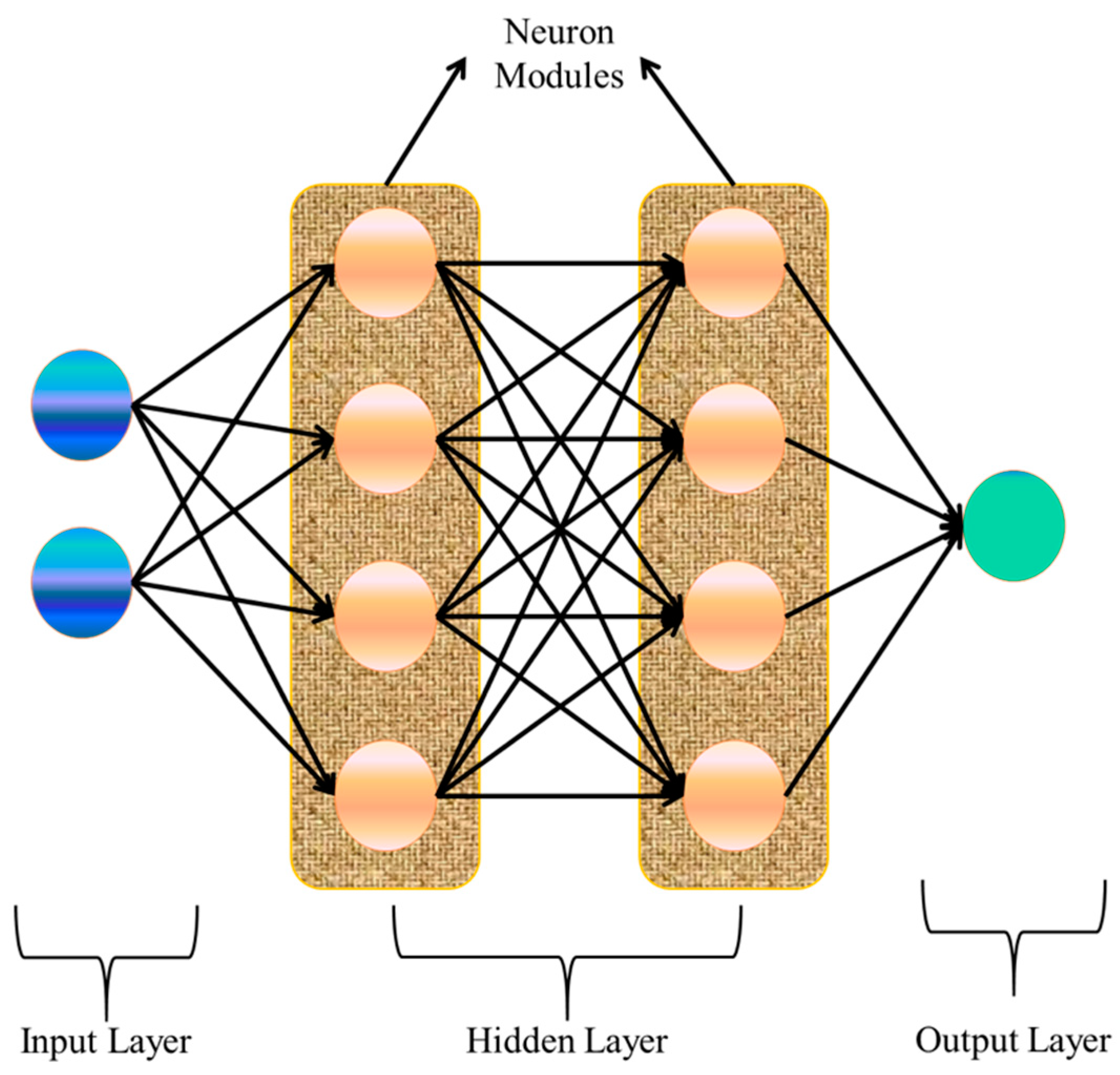
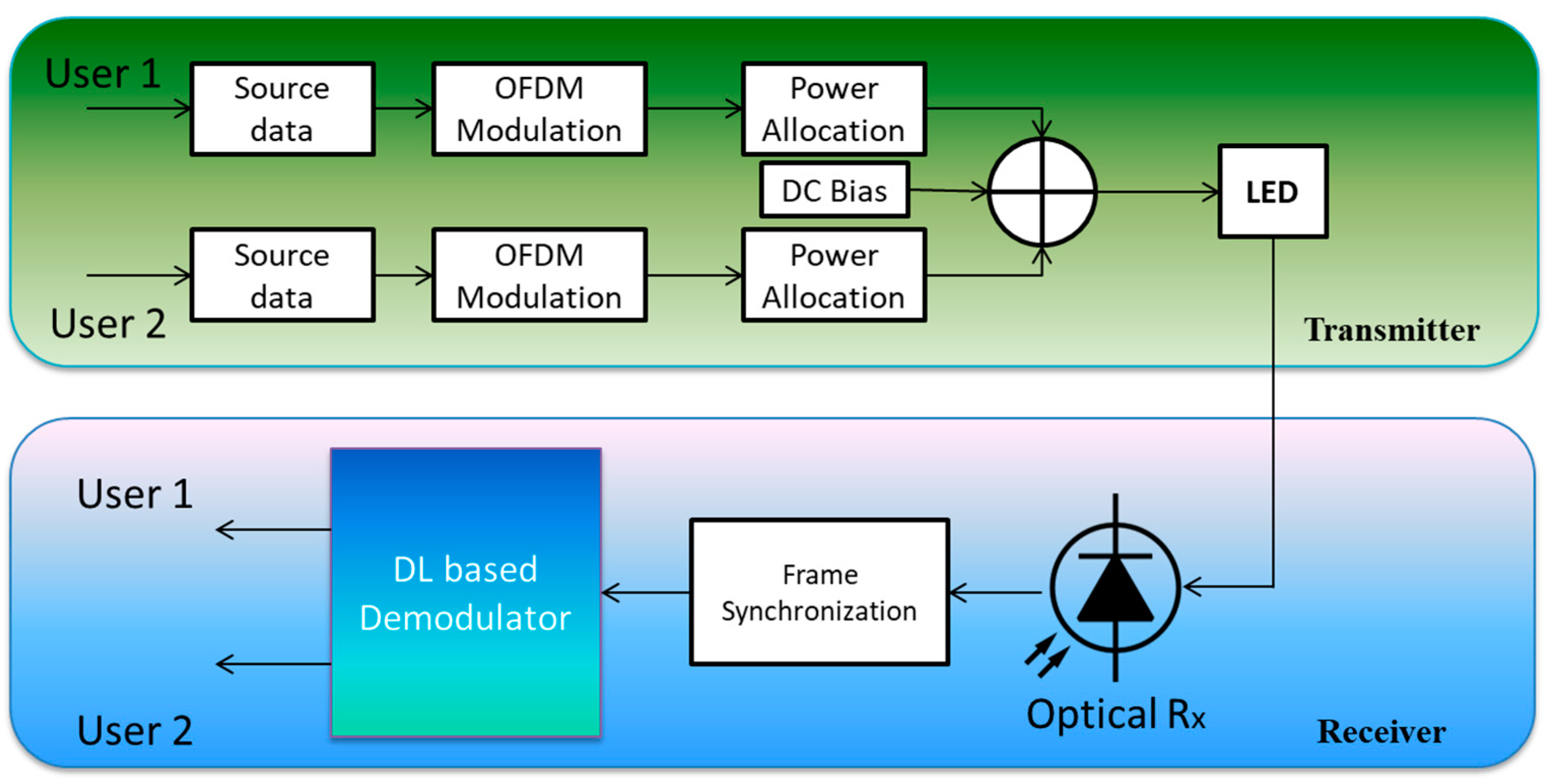
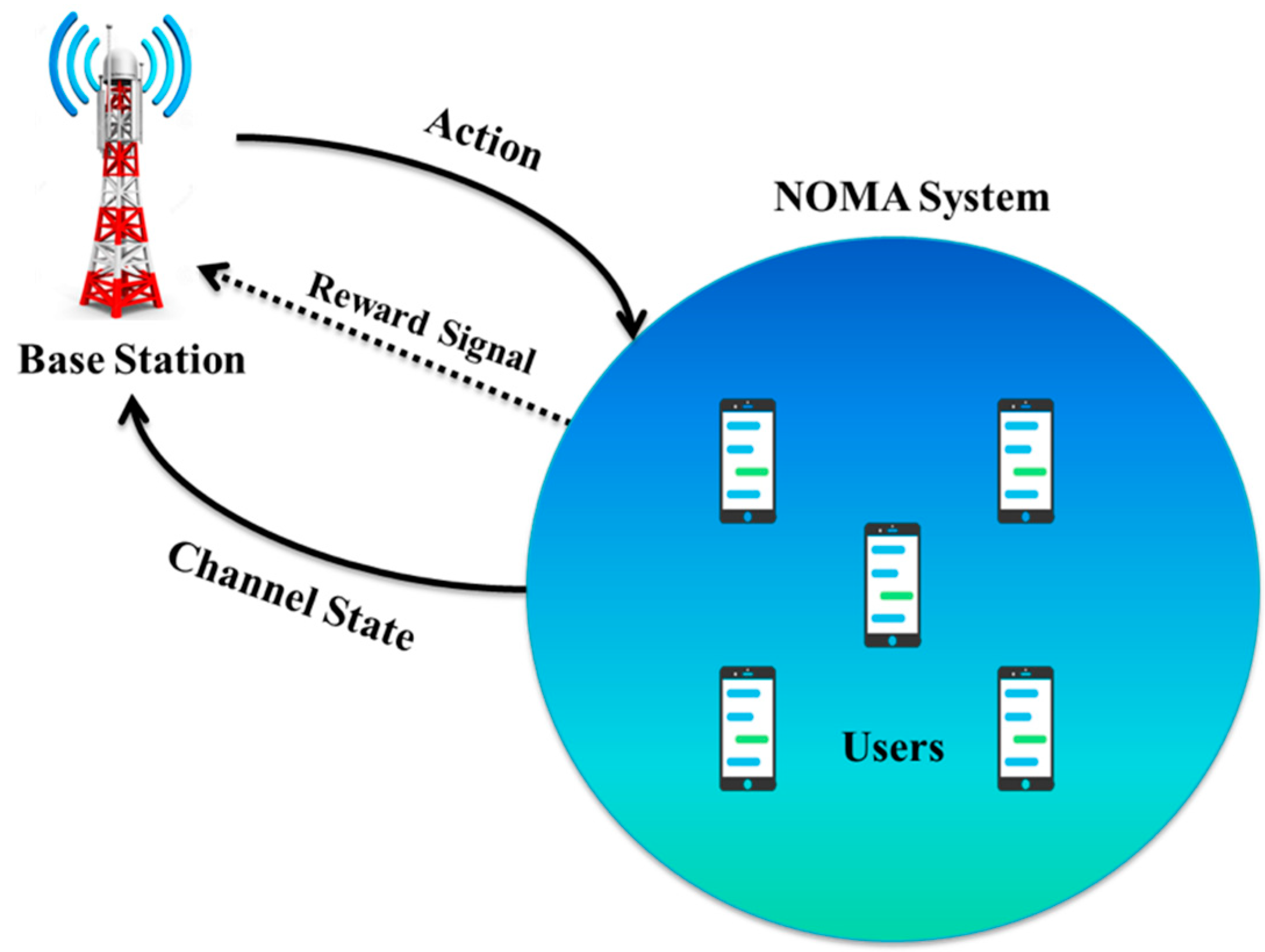
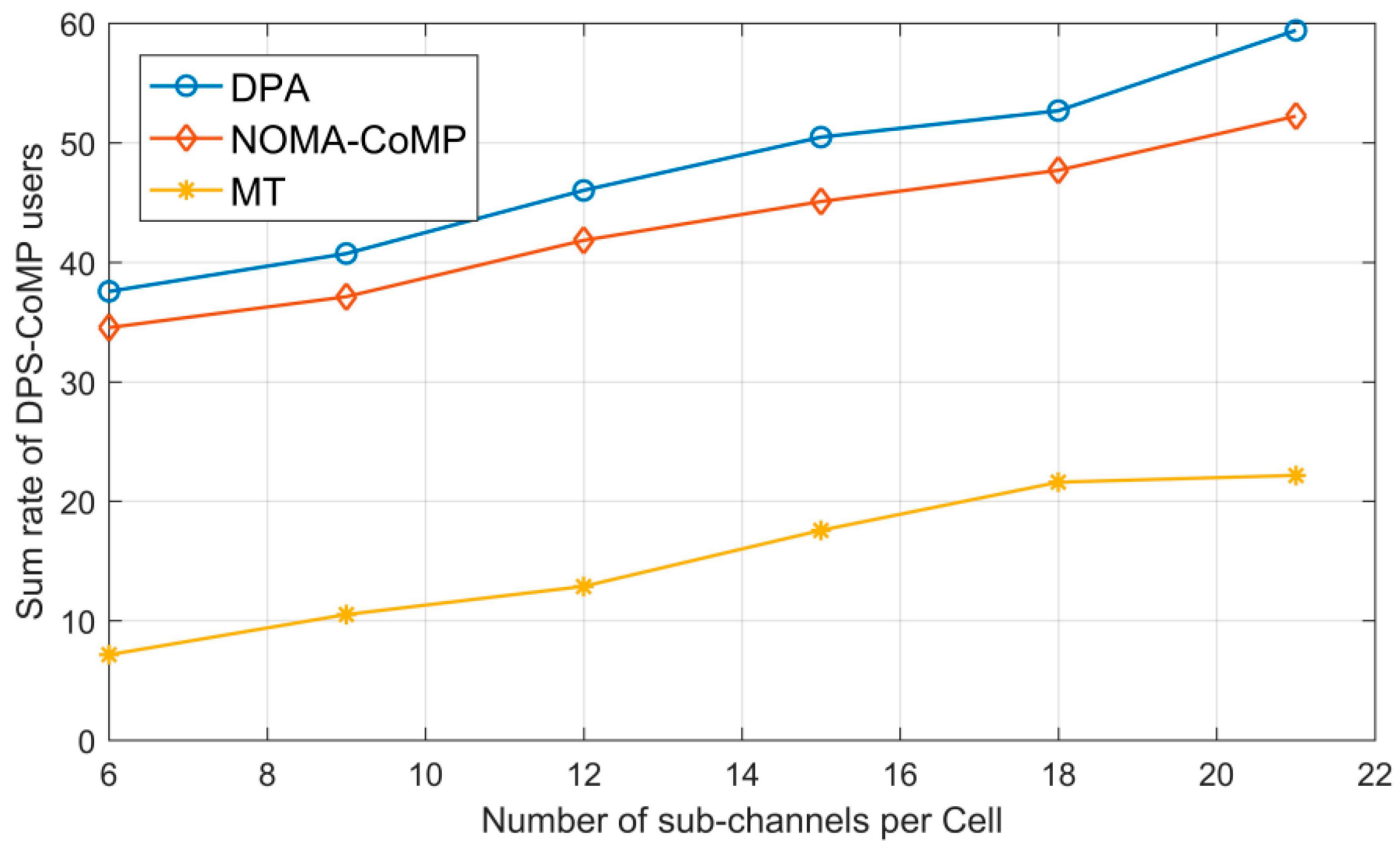


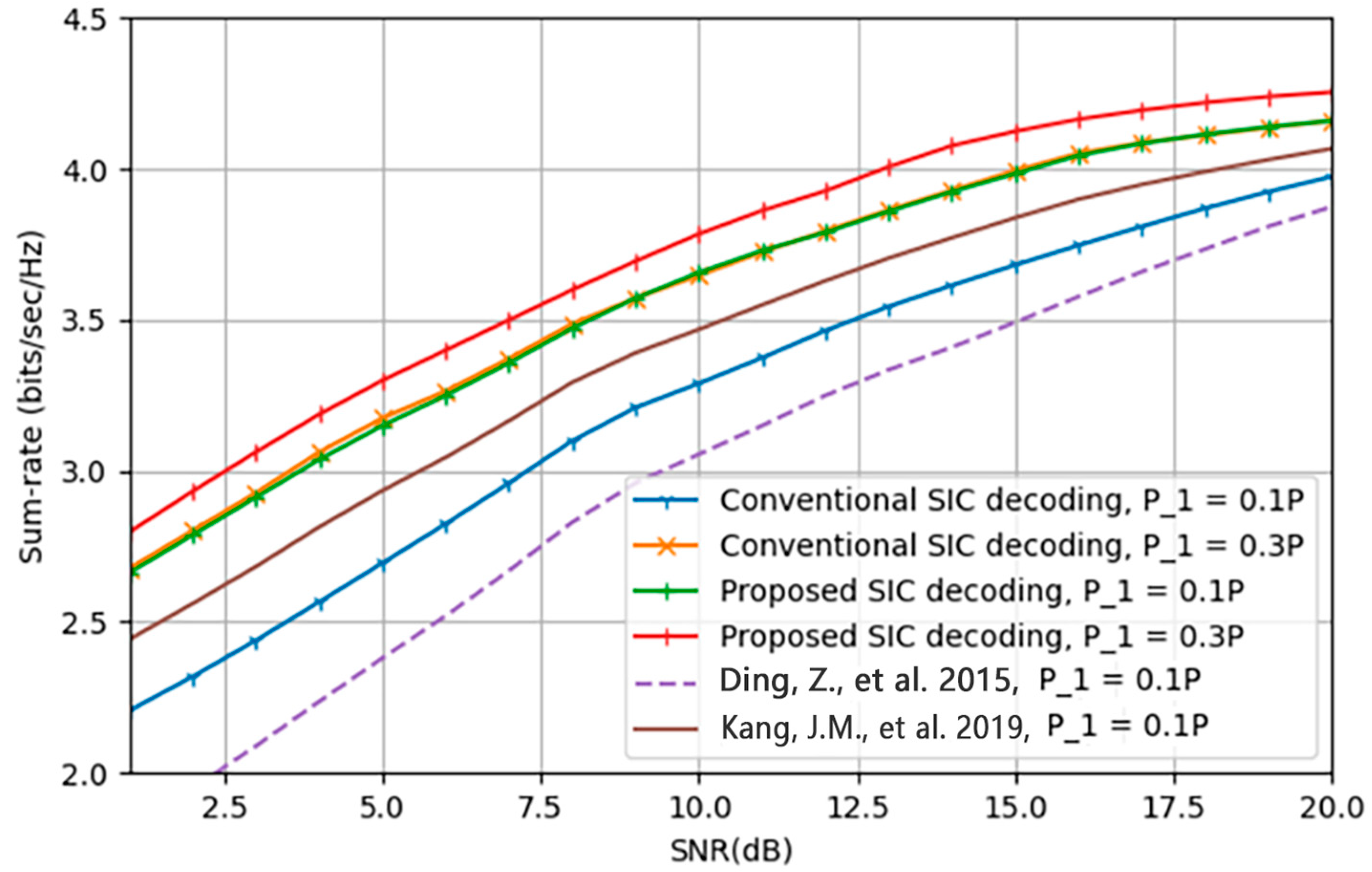
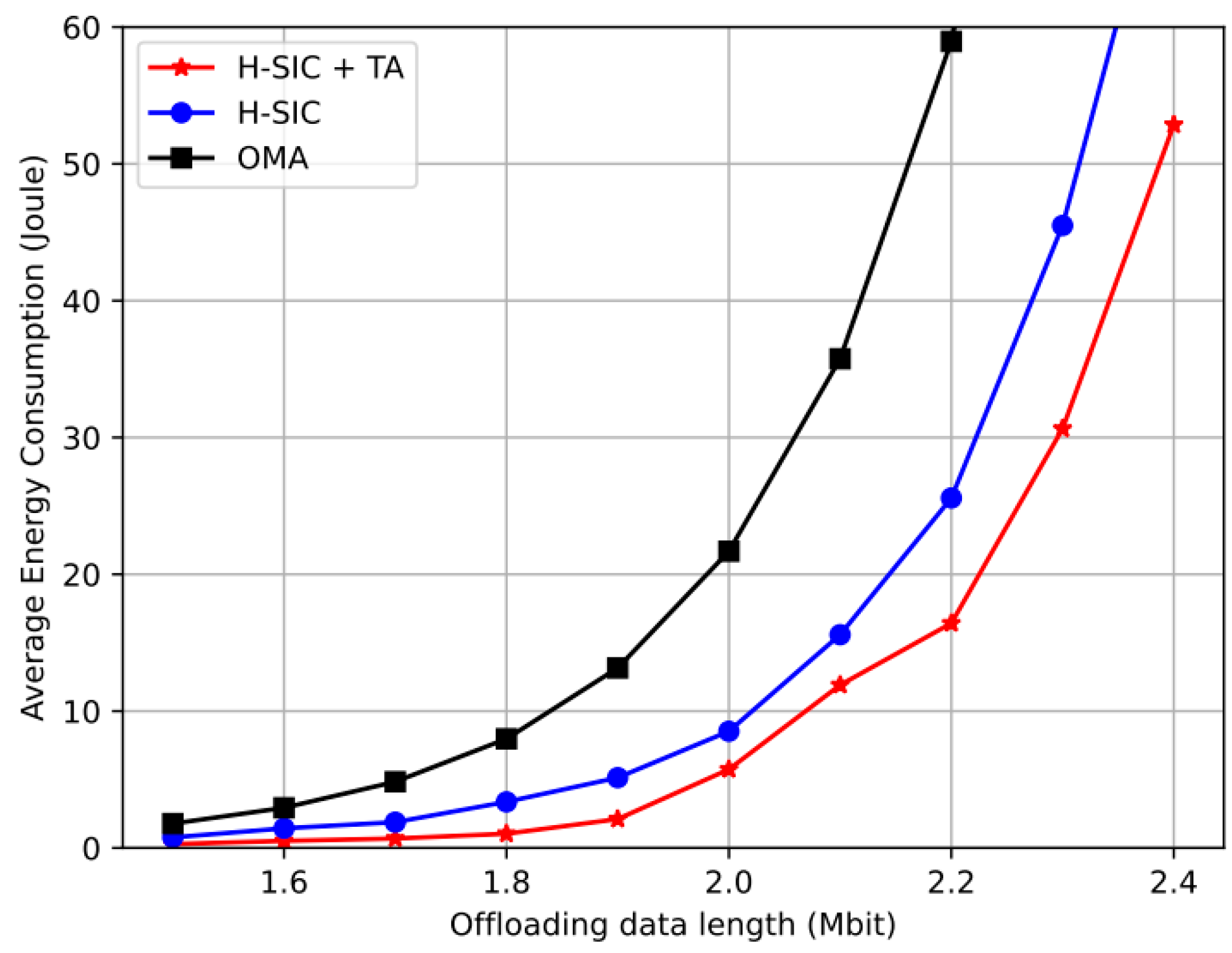
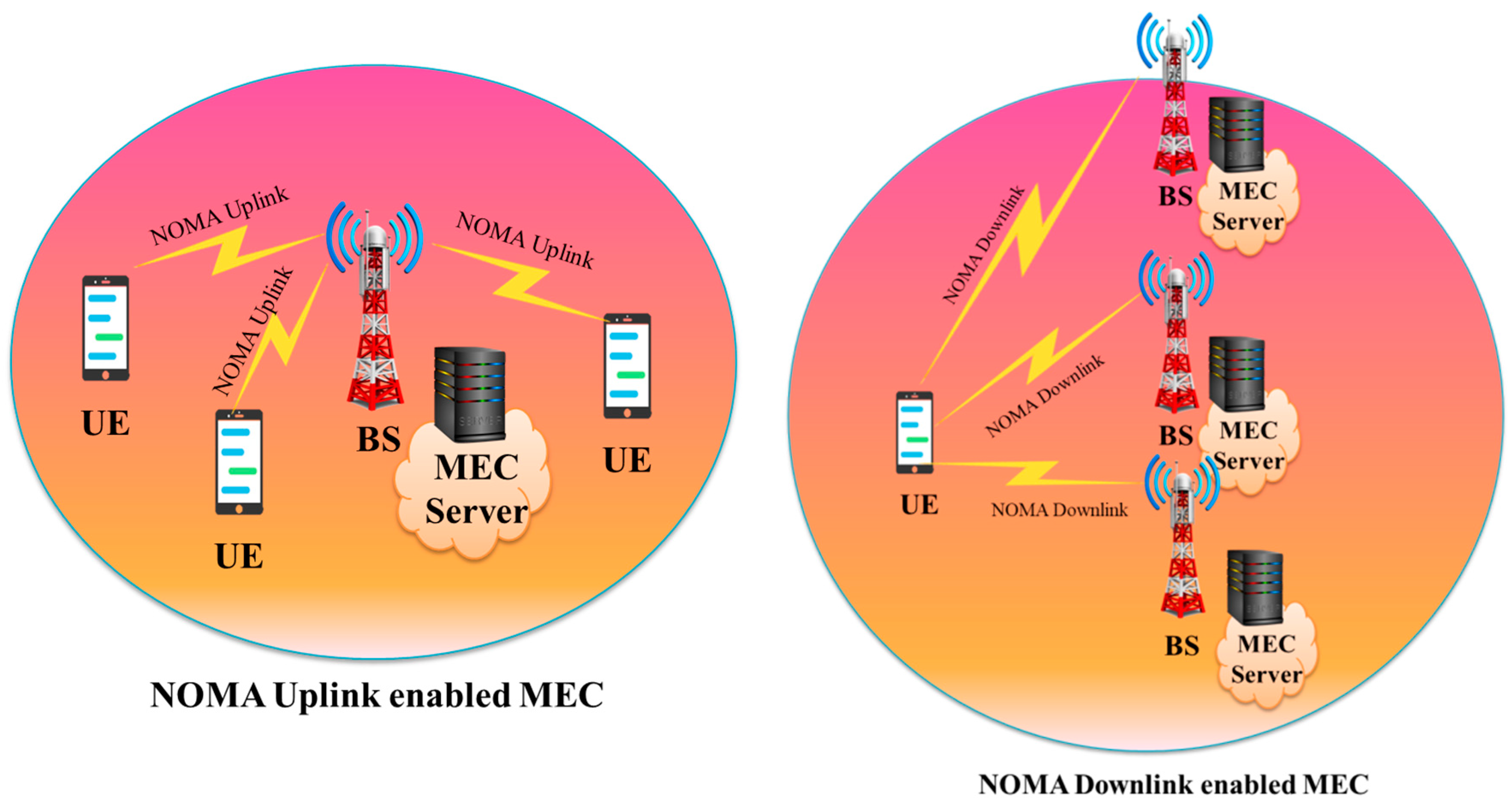


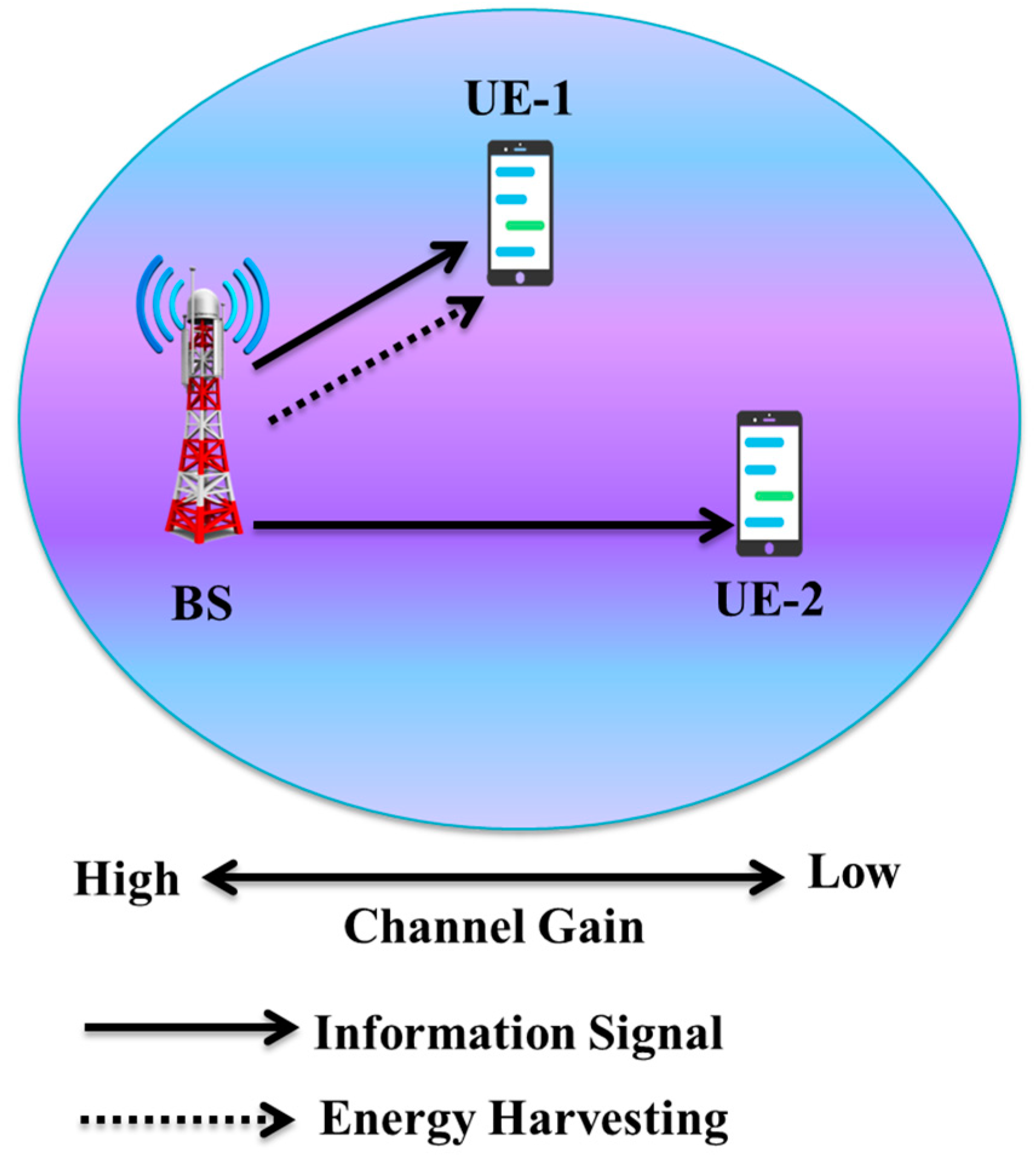
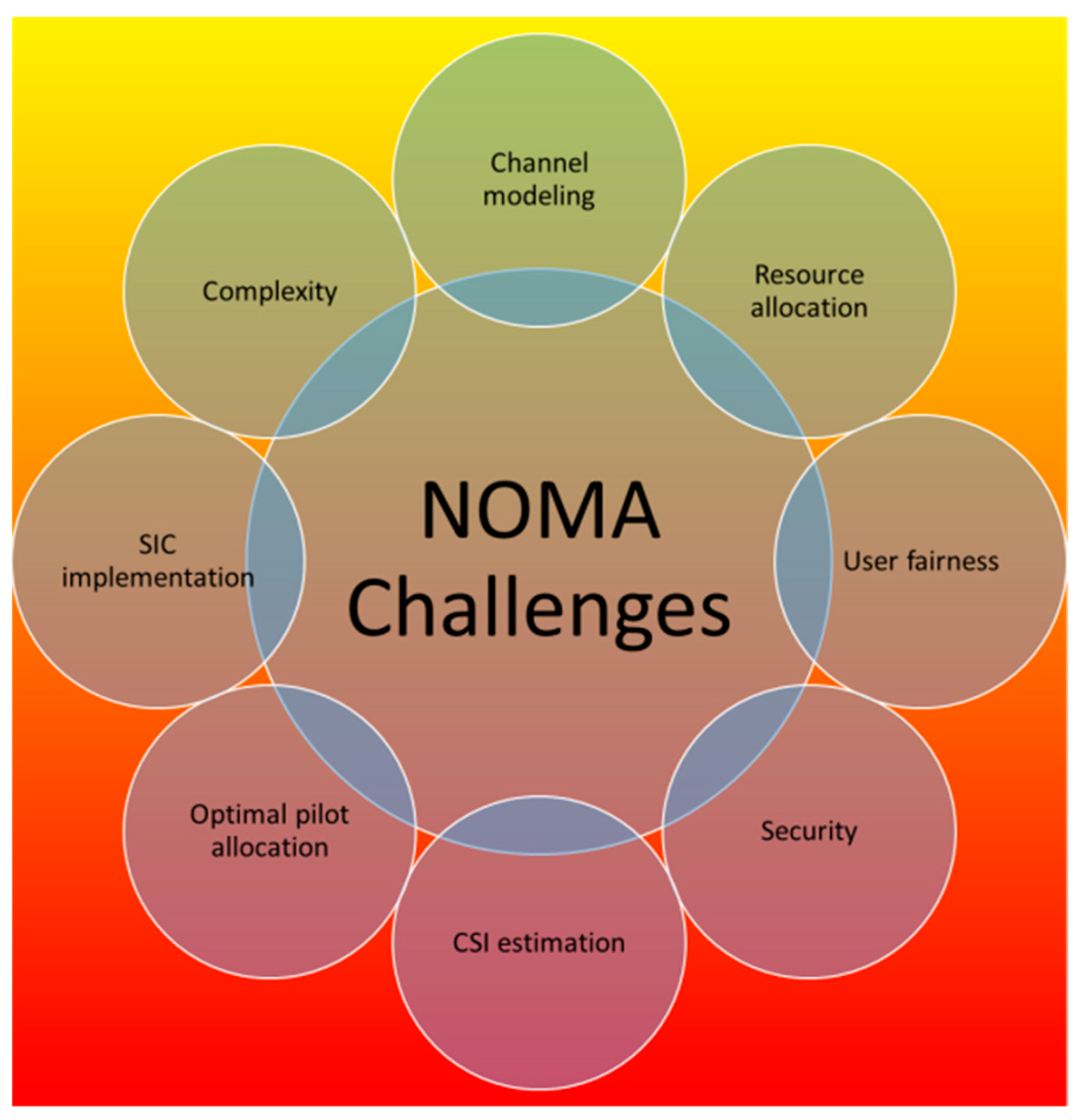
Disclaimer/Publisher’s Note: The statements, opinions and data contained in all publications are solely those of the individual author(s) and contributor(s) and not of MDPI and/or the editor(s). MDPI and/or the editor(s) disclaim responsibility for any injury to people or property resulting from any ideas, methods, instructions or products referred to in the content. |
© 2023 by the authors. Licensee MDPI, Basel, Switzerland. This article is an open access article distributed under the terms and conditions of the Creative Commons Attribution (CC BY) license (https://creativecommons.org/licenses/by/4.0/).
Share and Cite
Mohsan, S.A.H.; Li, Y.; Shvetsov, A.V.; Varela-Aldás, J.; Mostafa, S.M.; Elfikky, A. A Survey of Deep Learning Based NOMA: State of the Art, Key Aspects, Open Challenges and Future Trends. Sensors 2023, 23, 2946. https://doi.org/10.3390/s23062946
Mohsan SAH, Li Y, Shvetsov AV, Varela-Aldás J, Mostafa SM, Elfikky A. A Survey of Deep Learning Based NOMA: State of the Art, Key Aspects, Open Challenges and Future Trends. Sensors. 2023; 23(6):2946. https://doi.org/10.3390/s23062946
Chicago/Turabian StyleMohsan, Syed Agha Hassnain, Yanlong Li, Alexey V. Shvetsov, José Varela-Aldás, Samih M. Mostafa, and Abdelrahman Elfikky. 2023. "A Survey of Deep Learning Based NOMA: State of the Art, Key Aspects, Open Challenges and Future Trends" Sensors 23, no. 6: 2946. https://doi.org/10.3390/s23062946
APA StyleMohsan, S. A. H., Li, Y., Shvetsov, A. V., Varela-Aldás, J., Mostafa, S. M., & Elfikky, A. (2023). A Survey of Deep Learning Based NOMA: State of the Art, Key Aspects, Open Challenges and Future Trends. Sensors, 23(6), 2946. https://doi.org/10.3390/s23062946








